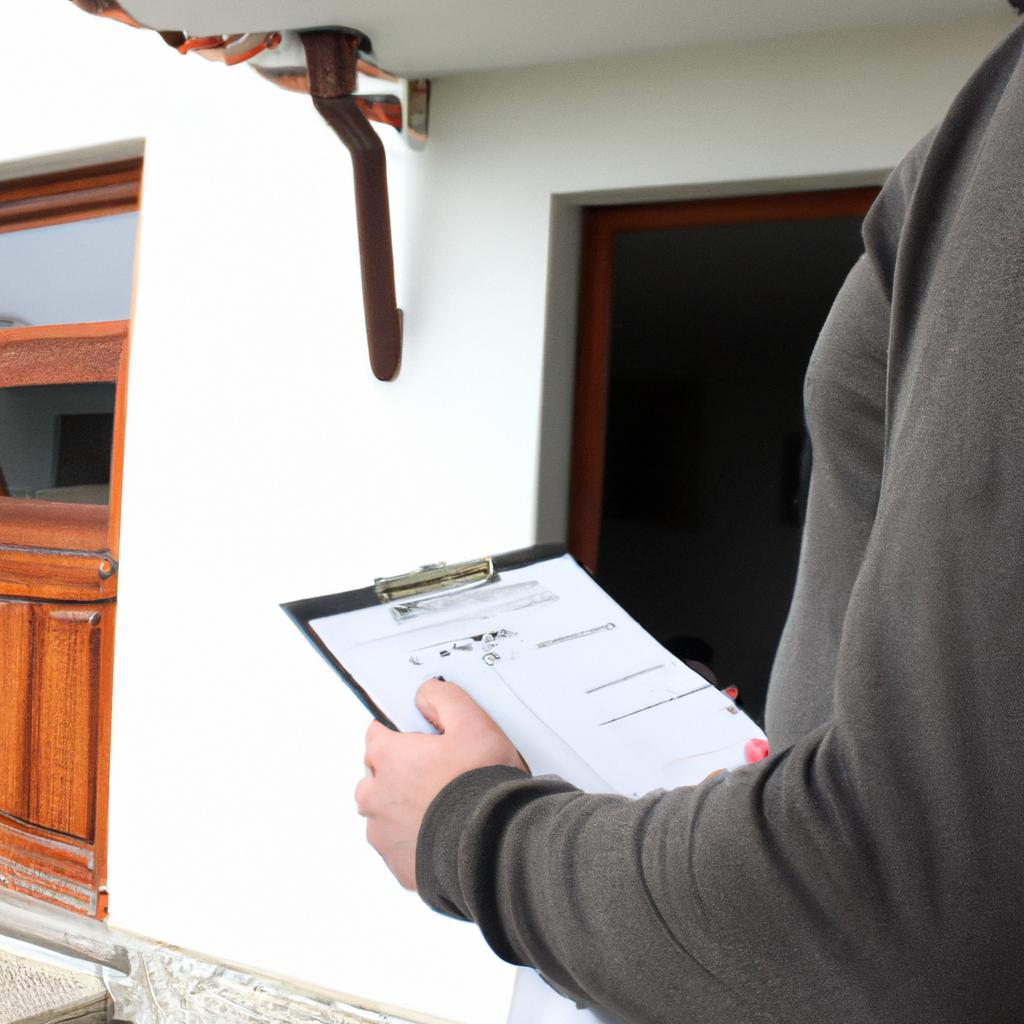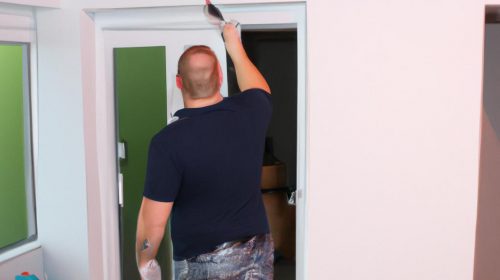Pre-Purchase Inspection: A Guide for Real Estate Home Inspections
Real estate transactions involve significant financial investments, making it crucial for buyers to ensure that they are well-informed before finalizing a purchase. One essential step in the home-buying process is conducting a pre-purchase inspection, which provides potential homeowners with a comprehensive evaluation of the property’s condition. For instance, consider a hypothetical scenario where John and Sarah are looking to buy their first house. They have found what appears to be an ideal home within their budget but want to assess its structural integrity and identify any potential issues before committing to the purchase.
A pre-purchase inspection serves as a critical tool for both homebuyers and sellers in understanding the current state of a property. This type of examination entails a thorough assessment conducted by professional inspectors who possess specialized knowledge and skills in identifying defects or deficiencies that may affect the value or safety of the dwelling. By examining various aspects such as electrical systems, plumbing, foundation, roofing, and overall structural integrity, these inspections provide valuable insights into the quality and maintenance requirements of the property. As each real estate transaction involves unique circumstances and properties, this guide aims to offer prospective buyers an overview of important considerations when undertaking a pre-purchase inspection for residential homes.
Importance of Pre-Purchase Inspections
Imagine this scenario: A young couple excitedly purchases their dream home, only to discover a few months later that the foundation is crumbling and the plumbing system is faulty. This unfortunate situation could have been avoided with a pre-purchase inspection.
A pre-purchase inspection is an essential step in the home buying process that involves hiring a professional inspector to assess the condition of a property before finalizing the purchase. It provides prospective buyers with crucial information about potential issues or hidden defects that may not be visible during a casual viewing.
The importance of pre-purchase inspections cannot be overstated, as they offer several significant benefits:
- Peace of Mind: By conducting a thorough examination, inspectors can identify any existing problems or potential risks associated with the property. Knowing these details upfront allows buyers to make informed decisions and avoid unexpected expenses down the line.
- Negotiation Power: Armed with comprehensive knowledge about the property’s condition, purchasers gain leverage during price negotiations. They can use any identified deficiencies as grounds for requesting repairs or negotiating lower prices.
- Safety Assurance: Ensuring safety within one’s own living space is paramount. A pre-purchase inspection helps uncover hazardous conditions such as electrical wiring faults, structural weaknesses, or mold infestations, enabling buyers to address these concerns promptly.
- Long-Term Investment Protection: Buying a home is often one of life’s largest investments. Conducting a pre-purchase inspection safeguards this investment by revealing potential maintenance needs and ensuring buyers are aware of both short-term fixes and long-term costs.
To understand better why pre-purchase inspections are vital, consider Table 1 below which outlines common issues found during inspections:
Table 1: Common Issues Found During Pre-Purchase Inspections
| Issue | Frequency | Impact | Cost (Average) |
|---|---|---|---|
| Plumbing problems | High | Moderate | $2,000 – $5,000 |
| Electrical issues | Medium | High | $3,500 – $8,000 |
| Roof leaks | Low | High | $4,500 – $12,000 |
| Foundation damage | Low-Medium | Very high | $10,000 – $30,000 |
In conclusion, a pre-purchase inspection is an indispensable tool for potential homebuyers. By providing crucial information about the property’s condition and identifying any hidden defects or risks, it ensures buyers can make informed decisions while protecting their investment.
Preparing for a Pre-Purchase Inspection
Section H2: Preparing for a Pre-Purchase Inspection
Imagine you are about to purchase your dream home. You have done all the necessary research, found the perfect location, and negotiated a good deal with the seller. Now, it’s time to prepare for the pre-purchase inspection that will ensure you make an informed decision before finalizing the purchase.
One example of why a pre-purchase inspection is important involves a hypothetical case where a couple was looking to buy an older house in a suburban neighborhood. The house appeared well-maintained from the outside, but during the inspection, several significant issues were discovered. These included outdated electrical wiring, plumbing leaks hidden behind walls, and structural damage due to termite infestation. Without this thorough inspection, these problems may have gone unnoticed until after they had already purchased the property.
To help you understand what to expect during a pre-purchase inspection process, here are some key points to consider:
- A comprehensive examination: A qualified inspector will conduct a detailed assessment of both the interior and exterior of the property. This includes checking for any signs of water damage or mold growth, inspecting the foundation for cracks or shifting, examining electrical systems for safety compliance, evaluating plumbing fixtures for leaks or blockages, and assessing HVAC systems’ functionality.
- Documentation and reports: Following the inspection, you can expect to receive a detailed report outlining all findings and recommendations. This report should include photographs of problem areas and prioritize any repairs or maintenance needed.
- Timeframe considerations: Keep in mind that scheduling an inspection may take some time as reputable inspectors tend to be in high demand. Plan ahead so that you can secure an appointment within your desired timeframe.
Here is an emotional bullet point list highlighting potential benefits resulting from a pre-purchase inspection:
- Peace of mind knowing that there are no major underlying issues with the property
- Increased bargaining power if repair costs need to be factored into negotiations
- Protection from unexpected financial burdens due to hidden defects
- Confidence in making an informed decision when committing to such a significant investment
Additionally, refer to the table below for a summary of common areas inspected during a pre-purchase inspection:
| Area | Inspection Focus | Potential Issues Found |
|---|---|---|
| Exterior | Roof condition and drainage system | Cracked shingles, clogged gutters |
| Foundation | Structural integrity and signs of settlement | Cracks, unevenness |
| Plumbing | Water supply lines, fixtures, drains, and sewage systems | Leaks, blockages |
| Electrical | Wiring safety and functionality | Outdated wiring, faulty outlets |
By adequately preparing for your upcoming pre-purchase inspection, you are taking proactive steps towards ensuring a smooth home-buying process. The next section will guide you through choosing a qualified inspector who can provide you with reliable insights into the property’s condition without bias.
Choosing a Qualified Inspector
Understanding the importance of preparing for a pre-purchase inspection is vital in ensuring a smooth and successful process. By taking the necessary steps before the inspection, you can save time, money, and potential headaches down the road.
Example Scenario:
To illustrate this point, let’s consider a hypothetical situation involving John and Sarah, who are looking to purchase their first home. They have found what appears to be their dream house, but before making an offer, they decide to schedule a pre-purchase inspection. This decision proves crucial as it helps them uncover hidden issues that would have otherwise gone unnoticed.
Preparing for a pre-purchase inspection involves several key tasks:
-
Researching the Property:
Gather information about the property beforehand by reviewing its history and any available documentation such as permits or previous inspection reports. Understanding the property’s background will help you identify potential areas of concern and allow you to ask more informed questions during the inspection. -
Making Necessary Arrangements:
Contact your real estate agent or seller to arrange access to the property on the scheduled day of inspection. Ensure all utilities are connected and functional so that inspectors can thoroughly assess various systems within the home. -
Clearing Obstacles:
Remove any clutter or personal belongings that may obstruct access to important areas like crawl spaces, attics, electrical panels, or heating units. Clear pathways enable inspectors to conduct comprehensive evaluations without restrictions. -
Taking Notes & Asking Questions:
During the inspection itself, take notes and photographs whenever possible. This will help you remember specific details later when discussing findings with your inspector or other professionals involved in the purchasing process. Don’t hesitate to ask questions along the way – knowledgeable inspectors are there to provide clarity and guidance.
- Peace of mind: Gain confidence in your investment knowing thorough inspections have been conducted.
- Financial protection: Uncover potential issues before purchasing, saving money on future repairs.
- Negotiation leverage: Use inspection findings to negotiate a fair price or request necessary repairs.
- Future planning: Understand the home’s condition to plan for maintenance and improvements effectively.
Creating Emotional Response Table:
| Benefit | Description |
|---|---|
| Peace of mind | Knowing your investment has undergone comprehensive inspections. |
| Financial protection | Identifying hidden issues early can save significant repair costs down the line. |
| Negotiation leverage | Using inspection findings as grounds for negotiating a lower purchase price or requesting repairs. |
| Future planning | Having an understanding of the home’s condition aids in effective long-term maintenance planning. |
Transition into subsequent section ‘Common Issues Found During Inspections’:
By adequately preparing for a pre-purchase inspection, you are setting yourself up for success in identifying any potential problems that may exist within the property. Once you have completed these preparations, it is essential to choose a qualified inspector who can thoroughly assess the home and provide accurate insights about its condition. Let us now explore how to select such an inspector and delve into common issues found during inspections without delay.
Common Issues Found During Inspections
Transitioning from the previous section on choosing a qualified inspector, it is important to understand common issues that are often found during home inspections. To illustrate this point, let’s consider a hypothetical scenario where a potential buyer has hired a qualified inspector for a pre-purchase inspection.
During the inspection of this particular property, the inspector discovered several key issues that needed attention. Firstly, they identified water damage in the basement due to poor drainage around the foundation. This finding highlighted the importance of proper grading and waterproofing systems to prevent long-term structural damage.
Secondly, the inspector noticed outdated electrical wiring throughout the house. This raised concerns about potential safety hazards and indicated the need for an electrician to assess and possibly update or repair the system.
Lastly, evidence of termite infestation was found in some areas of the property. The presence of termites can cause significant damage if not addressed promptly, emphasizing the necessity for professional pest control measures.
Understanding these common issues can help buyers be more informed and prepared when undergoing their own inspections. Here are four additional points to consider:
- Structural integrity: Ensure that there are no major cracks or signs of shifting foundations.
- Plumbing system: Check for leaks, adequate water pressure, and functioning fixtures.
- HVAC system: Assess its age, condition, and energy efficiency.
- Roof condition: Look out for missing shingles or signs of deterioration.
In addition to understanding these points, it is also helpful to have knowledge about how inspectors report their findings. Below is a table outlining three categories commonly used in inspection reports:
| Category | Description |
|---|---|
| Major Defects | Issues that require immediate attention due to safety or substantial costs. |
| Minor Defects | Less critical concerns that may still need addressing but do not pose risks. |
| Deferred Items | Areas requiring further evaluation by specialists before conclusions can be made. |
By familiarizing yourself with these categories, you can better comprehend and prioritize the issues identified in an inspection report.
Transitioning into the subsequent section about understanding inspection reports, it is essential to be equipped with this knowledge when reviewing and discussing the findings. By doing so, buyers can make informed decisions regarding their potential real estate investment without relying solely on a step-by-step guide.
Understanding Inspection Reports
After a thorough inspection of the property, the next step in the pre-purchase inspection process is understanding the inspection report. This document provides a detailed overview of the inspector’s findings and serves as a crucial tool for both buyers and sellers to assess the condition of the home. Let us delve into what you can expect from an inspection report.
Example: To better illustrate this process, let’s consider a hypothetical scenario where John and Sarah are prospective buyers looking to purchase a house. They receive an inspection report that highlights several issues with the property, ranging from minor cosmetic concerns to more significant structural problems.
When reviewing an inspection report, it is essential to pay attention to specific sections that outline any major defects or safety hazards present in the property. These could include issues such as faulty electrical systems, plumbing leaks, or compromised foundations. Identifying these key problem areas will help you understand the severity of any repairs required before finalizing your decision.
To make understanding your inspection report easier, here are some key points to keep in mind:
- Bullet Point 1: Familiarize yourself with industry terminology used in the report.
- Bullet Point 2: Pay close attention to items flagged as “major” or “safety concerns.”
- Bullet Point 3: Take note of recommended actions for each issue raised.
- Bullet Point 4: Consider seeking expert opinions if further evaluation is suggested.
In addition to textual descriptions within an inspection report, visual aids like photographs may also be included. These images offer a clearer representation of identified issues and can assist both buyers and sellers in their decision-making process.
| Item | Description |
|---|---|
| Defects Found | The number and severity of defects discovered during inspections can vary greatly depending on factors such as age, maintenance history, and previous renovations. It is vital to evaluate whether these defects align with your expectations for a home in its current condition. |
| Cost Implications | Understanding the potential financial implications of necessary repairs is crucial for budgeting purposes. Consider obtaining estimates from contractors or professionals to assess the approximate costs associated with addressing identified issues. |
| Safety Concerns | Ensure that any safety hazards highlighted in the inspection report are given immediate attention and remedied promptly to avoid compromise to your well-being or that of future occupants. |
| Maintenance Requirements | The report may also provide insights into long-term maintenance requirements, helping you plan for ongoing upkeep and preventative measures to preserve the value and integrity of your investment over time. |
In summary, a thorough understanding of your inspection report is essential for making informed decisions when purchasing a property. By carefully reviewing key sections, paying attention to industry terminology, and considering expert opinions where necessary, buyers can gain valuable insights into the true condition of their prospective homes.
Transitioning seamlessly into the subsequent section on “Negotiating Repairs and Price,” it is important to assess how the findings in your inspection report can influence negotiations with sellers regarding necessary repairs and adjustments to the purchase price.
Negotiating Repairs and Price
Section H2: Negotiating Repairs and Price
After understanding the inspection reports, the next crucial step is negotiating repairs and price. Let’s consider a hypothetical scenario to better comprehend this process. Imagine you are interested in purchasing a home that has some significant repair issues identified during the inspection. Now, let’s explore how to navigate this situation effectively.
When it comes to negotiating repairs and price, keep the following key points in mind:
- Prioritize your concerns: Review the inspection report thoroughly and prioritize the repairs based on their severity and potential impact on the property’s value or safety.
- Seek professional advice: Consult with contractors or specialists to obtain accurate estimates for each repair item. Their expertise will provide you with valuable insights when discussing costs with the seller.
- Strategize your approach: Determine whether you want the seller to complete all necessary repairs before closing or if you prefer receiving a credit at closing so that you can address them yourself after purchase.
- Communicate effectively: Clearly articulate your concerns and desired resolution to the seller through your real estate agent or directly if applicable. Open lines of communication can help facilitate negotiations amicably.
To illustrate negotiation strategies further, here is an example table showcasing possible scenarios along with corresponding approaches:
| Repair Issue | Approach |
|---|---|
| Roof leakage | Request repair by licensed contractor |
| Plumbing problem | Credit at closing for plumbing system replacement |
| Electrical wiring | Seller completes electrical upgrades pre-closing |
| Foundation issue | Jointly hire structural engineer for evaluation |
Remember that negotiations should be fair and reasonable, taking into account both parties’ interests and potential financial implications of various options discussed.
In summary, negotiating repairs and price after reviewing inspection reports requires careful consideration of priorities, seeking expert opinions, strategizing one’s approach, and maintaining effective communication channels with all involved parties throughout the process. By employing these strategies, you can increase your chances of reaching a mutually beneficial agreement that addresses necessary repairs while maintaining the integrity of the home buying transaction.



